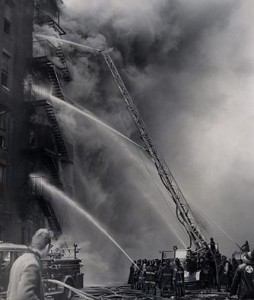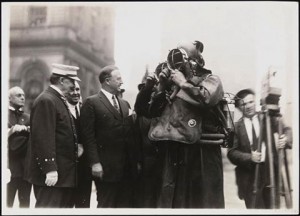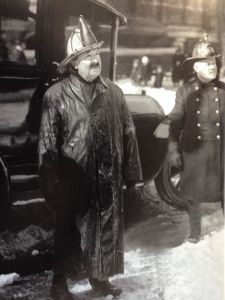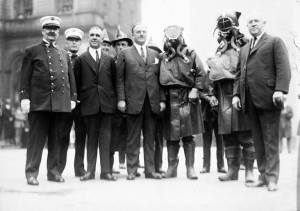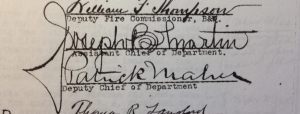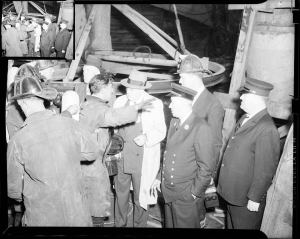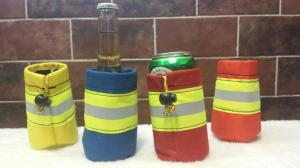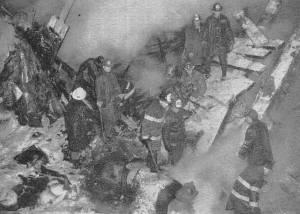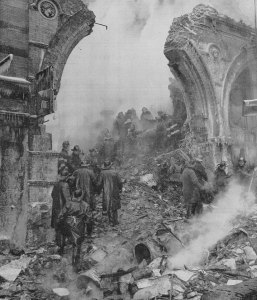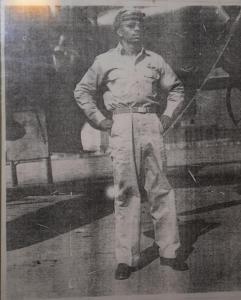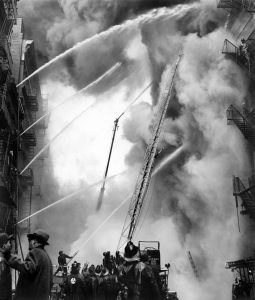From the Vault:
March 6, 1964 Brooklyn. The initial alarm was received at 10:30 in the morning. Five alarms were transmitted for Box 491, for a fire in the Straus department store at 173 Plymouth Street. This stubborn and very smoky fire severely tested the FDNY and refused to go out. In addition to the five alarm response, a Borough Call was requested at 5:08 pm, sending three additional alarms worth of companies to the scene from Manhattan. (77-491-66-33-367- in English that’s Manhattan third alarm assignment to Box 367 goes to Brooklyn Box 491). Later, the wall and roof collapsed, wrecking Engine 208 and damaging Engine 207. The flames burned out of control for more than 20 hours. Paul Hashagen -Author www.gettinsaltyapparel.com
Author Archives: Salty Dog
FDNY Rescue 1
From the Vault: Assistant Chief “Smoky Joe” Martin, Mayor Hylan and others inspecting FDNY Rescue 1 members wearing smoke helmets. The photo was taken at the Medal Day celebration June 20, 1922.
www.gettinsaltyapparel.com
Smoky Joe Martin FDNY
When Joseph B. Martin joined the FDNY in 1884, he was one of the only firemen on the job with a college education. He rose quickly through the ranks. While in command of Engine 31 he would earn his now world famous nickname.
On a cold winter night in 1899 Martin led an attack on a dangerous cellar fire in a large warehouse. Despite the fact the nozzle teams had to keep changing men, Martin stayed at the lead. Man after man took his turn at the knob only to be driven from his position by the heavy smoke and high heat conditions. Soon his entire company was laid out in the street unconscious or gasping for air. After watching yet another company stumble out into the street, Chief Croker ordered everyone out.
Martin remained.
The chief crawled in himself. After three attempts to reach the nozzle the veteran chief finally found Martin, nozzle in hand wedged between packing crates battling the flames. Crocker grabbed him by the collar and pulled him out.
In the street, Croker announced, half-angry and half-proud “Gentlemen, this is Smoky Joe Martin. By the gods he certainly does love it!”
The nickname stuck.
The salty fire officer would continue up the ranks until he became Assistant Chief. Martin commanded some of the most dangerous and difficult fires any fire officer has ever faced. He continued leading his beloved men until he was forced to retire in November 1930. He died at home 11 years later.
In 1944, the now famous character “Smokey Bear” was named after him.
The photos show Martin with his driver “Daredevil Dan” Healy. Martin far left with smoke helmeted Rescue 1 men and the mayor at Medal Day 1916. And Martin’s ornate signature on a report from the Board of Merit. Paul Hashagen www.gettinsaltyapparel.com
Brooklyn Battery Tunnel Fire
From the Vault:
Great photo of Rescue 1 Captain Patrick Green reporting to the fire commissioner and having his “Scott bottle” changed. The scene of this difficult and dangerous major fire was inside the still under construction Brooklyn Battery Tunnel on May 14, 1947. The entire company made several trips through pressurized air-locks to reach the seat of the fire in the blazing tunnel. Green was awarded the Bennett Medal and every man working the tour in Rescue 1 (11 men) also were awarded a medal for their heroic operation. I think this is the only time in the history of the FDNY that ever happened. The fire took more than 2 -1/2 hours to extinguish.
Bunker Gear Style Koozie
What a perfect way to beat the summer heat and show your pride than with a Bunker Gear Style Koozie.
All of our koozies are high quality, heavy duty durable Cordura.
Made in the USA. These are a great Fireman’s gift! #bunkergearkoozie
Includes 5mm neoprene center to keep your beverage cold! A step up from your average PU Foam Coolers, neoprene is a material often used in wetsuits to allow for maximum insulation and comfort. These bunker gear style neoprene koozies are sure to be a favorite among your friends. Available in your choice of Black, Orange, Yellow, Red, Blue, and Pink . Measures: 5in high x 3.5 round diameter
Valentines Day FDNY 1958
From the Vault:
Valentine’s Day 1958
At 6:51 pm Manhattan Box 334 was transmitted for a fire in a six-story loft building at 137 Wooster Street. At the height of the multiple alarm fire, three floors of the Elkins Paper & Twine Company building collapsed trapping numerous members. Five-alarms were struck, and hundreds of off-duty members descended on the scene despite heavy snowfall, bitter winds and icy conditions. Rescue 1 was joined by Rescue 2 in a major tunneling and shoring operation in hopes of reaching two FDNY firemen and four members of the Fire Patrol trapped in the huge, frozen pile of rubble.
Conditions were so dangerous a crane was brought in to remove a large overhanging section of the building that was threatening to crash down upon the rescuers. The operation continued on into the following day, despite another major fire, a fourth-alarm in a lower east-side tenement only blocks away.
Sadly, the six men could not be saved.
FDNY Sleds?
As far back as 1793 the volunteers of New York City had sleds built to help respond through the snow filled streets. In that year, because of heavy snow the December before, sleds were built for Engine Companies 17, 18, and 19. (19 even was allowed 2 additional members to help pull the rig- due to their longer responses.)
The cool picture of Black Joke Engine 33, shows their goose-neck pumper fitted with “runners” for hauling the machines through heavy snow. The other picture shows E-33 on the deck of a ship at the foot of Wall Street during the Great Fire of 1835. They were relaying water from a patch of open river to other pumpers on shore. Remember, all pumping then was done by hand!
* I have found no other mentions of the paid FDNY of using sleighs except the below photograph.
FDNY Lt. John Mulzac
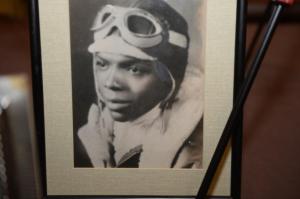
Retired FDNY Lt. John Mulzac, a Tuskegee Airman who took to the skies in three wars, died this week.
He was 91.
Mulzac, a Brooklyn resident who was affectionately called Daddy John, was an original member of the elite Tuskegee Airmen, a group of 994 pilots who in World War II became the first African-American aviators in the history of the U.S. armed forces.
To his family, Mulzac, who died Sunday, was also a prankster and storyteller whose barrier-breaking history spoke for itself. But it was a tale the Bedford-Stuyvesant man enjoyed sharing nonetheless.
“They said that we could never fly airplanes, were not capable of flying airplanes,” Mulzac recounted to an auditorium of students at St. Saviour High School in Brooklyn in 2001. “But there were some people on our side.” The heroism shown by the Tuskegee Airmen is said to have influenced President Harry S. Truman’s decision to desegregate the military in 1948. The airmen were awarded the Congressional Gold Medal in 2006, the highest honor bestowed by Congress.
“Despite the tough times of segregation he went through, he always felt this was the best country in the world,” said son Henry Mulzac, 60, a retired NYPD detective. “He was so grateful for what this country did for him and felt the service was worth it.”The pioneering pilot moved from manning flight controls to manning fire hoses when he became a smoke eater for the FDNY in 1947. He also started a family with his wife Beatrice, who pinned on his pilot wings at his graduation from the Tuskegee Institute in Alabama in 1944. When the country called on Mulzac again, he left the firehouse to fly missions in the Korean and Vietnam wars as a reservist.
He retired from the Fire Department in 1967 as a lieutenant, then worked as a sky marshal and as a U.S. Customs inspector before retiring for good to concentrate on his role as the patriarch of a sprawling brood of eight children, 22 grandchildren and eight great-grandchildren, his family said.
Mulzac, who died Sunday, is survived by his wife, eight children, 22 grandchildren and eight greatgrandchildren.
“He was a man of integrity and he loved his children, and in his life he wanted to see them all get an education and strive for the best,” wife Beatrice Mulzac, 88, said Thursday at his wake.
That drive was an inspiration for the success of his family. His son Robert Mulzac followed in his father’s footsteps and is a retired FDNY lieutenant. Two of his grandkids, Channing Frye and Tobias Harris, play NBA ball for the Orlando Magic.
“What an inspiration. I knew I could do and be whatever because of him,” his daughter, Karen Mulzac-Frye said after Mulzac’s wake.“Now that he’s gone, I’ve got to work even harder.”
FDNY Rag Shop Fire 1957
The Unbelievable Story of Collyers Mansion
